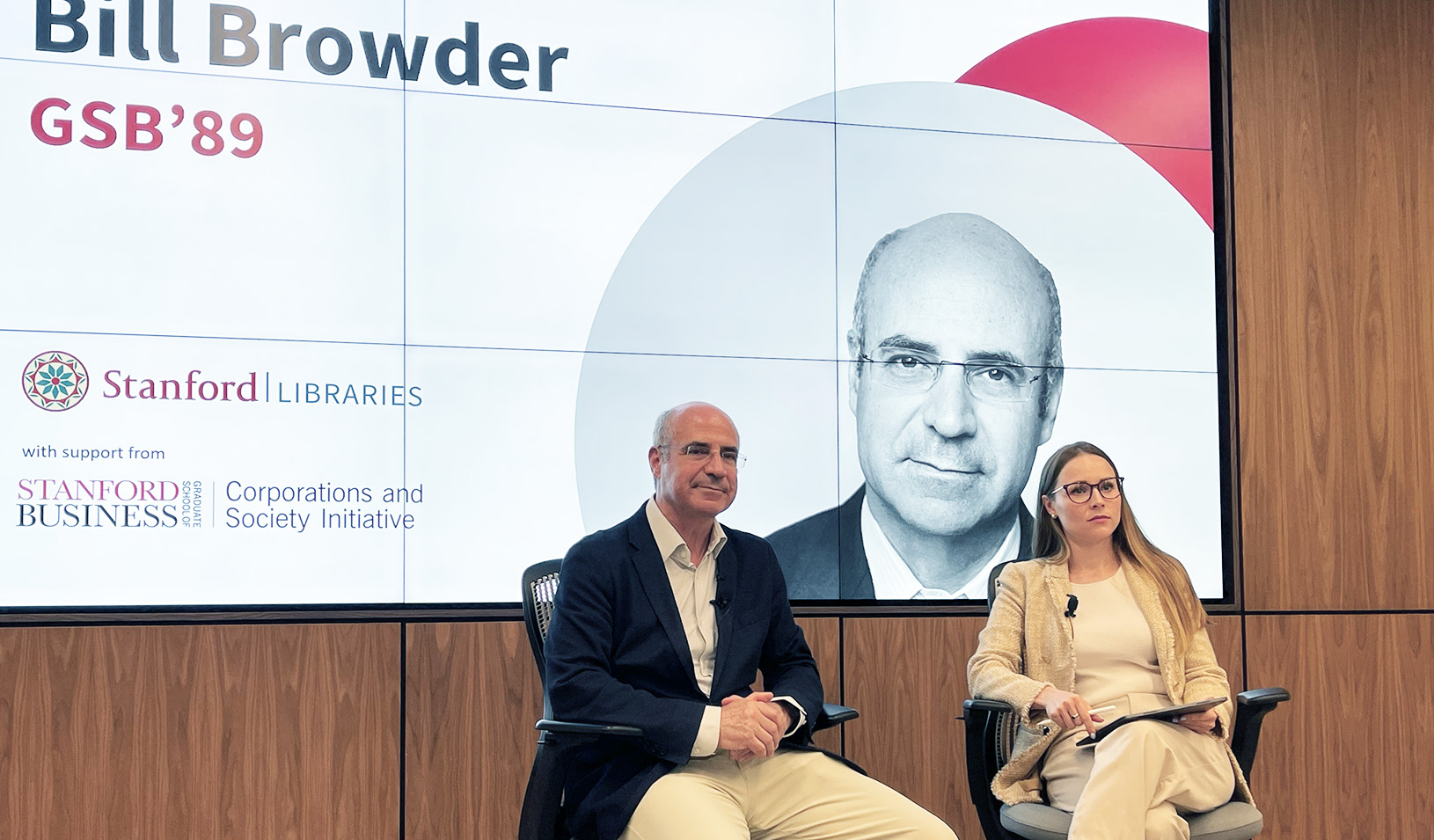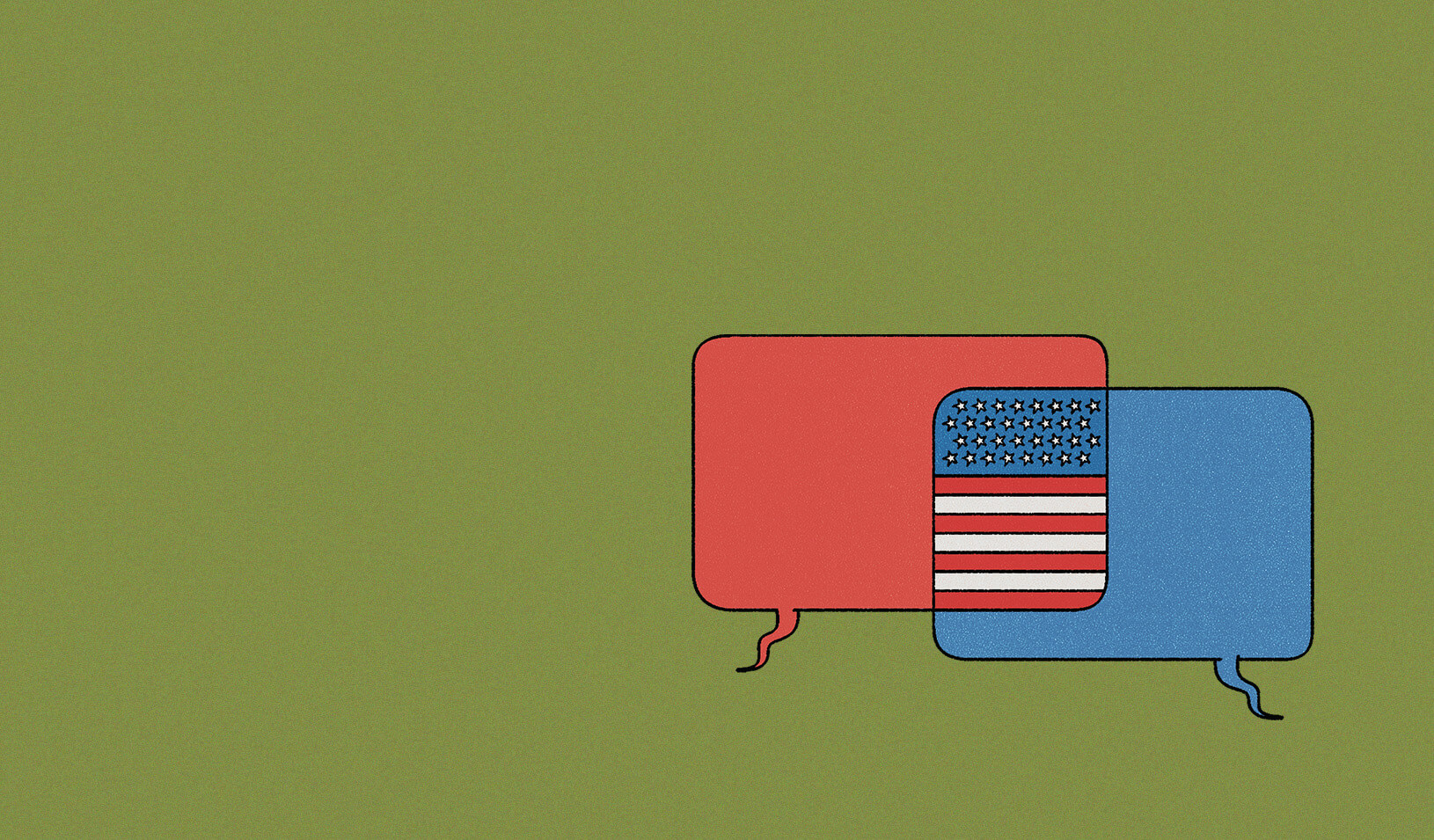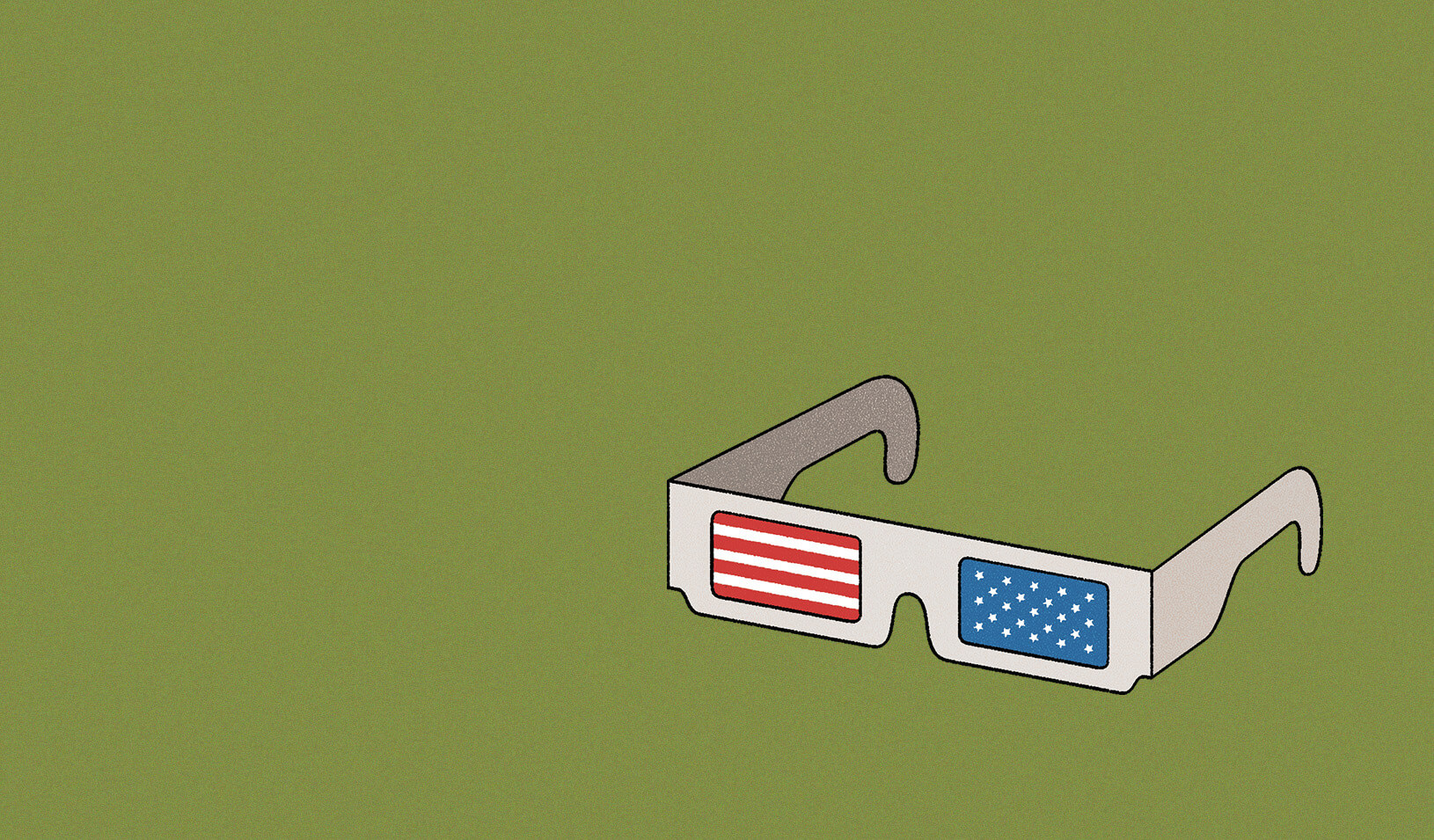
Illustrations by Álvaro Bernis
Why did the political middle disappear and what would it take to restore it? David. W. Brady, Saumitra Jha, David Dodson, Steven Callander, and Anthony Gonzalez offer some ideas.
Remember Bipartisanship

David W. Brady is a professor of political economy, emeritus, at Stanford GSB and senior fellow at the Hoover Institution.
Pulling Back From Polarization
In this Stanford Business three-part article, researchers, policy experts, and politicians discuss ways to establish common ground, work together, and strengthen democracy.
You’ve written about how polarization in Congress is nothing new. Is there anything different about our current situation?
David W. Brady: We’ve had periods of intense polarization before — obviously, in the Civil War. There’s a lot of affective polarization when you’re shooting at each other! We’re not there yet. But I do think it’s worse than it had been. The Congress is relatively dysfunctional compared to other periods.
Roughly from about the ’40s until the present era, there was a lot of bipartisanship. When you had a bunch of conservative Democrats and liberal Republicans, as we did through the ’70s and even into the ’80s, it was harder for Democrats to bad-mouth conservatives. It was harder for Republicans to totally bad-mouth liberals because they had some in their own party and needed them. So there was always that mitigating factor. That’s gone.
Moderates don’t run anymore. A Democrat or a Republican who’s toward the middle, they get beat in primaries. So that pushes Democrats further left and Republicans further right and you can’t get legislation. That increases polarization.
If polarization is a fairly normal state of affairs, is it necessarily a bad thing? We’ve been able to accomplish a lot with a divided government.
Brady: That’s the $64 question. My view is that up until Trump, the parties could get major policy changes done. The Democrats under Obama did pass the Affordable Care Act; it didn’t get repealed. The Republicans passed the Trump tax cut. But I do think at this point, there is a serious question about the ability of the Congress to get meaningful policy on climate change, inequality, guns, and so on passed.
Are there systemic changes that could reduce polarization?
Brady: I do think primaries are exceedingly problematic because they reward the extremes. They tried open primaries in California to solve the problem, but we don’t have the full results in yet. One thing political scientists are pretty big on is ranked-choice voting. In a ranked choice voting system, centrist, compromise-oriented candidates have a better chance against the extremes. But I don’t think it’s the be-all and end-all that people have said that it would be.
Reclaim the Middle

David Dodson, MBA ’87, is a lecturer in management at Stanford GSB.
What did your experience in 2018 running as a Republican for U.S. Senate in Wyoming teach you about the state of political polarization?
David Dodson: It taught me that polarization and partisanship are what both parties want because the one thing they can agree on is dividing the population into a red camp and a blue camp and then gerrymandering like crazy. You have to go after the structural issues, which are around term limits, gerrymandering, campaign finance reform, and how the primaries are run.
If you’re running for a House district, you’re going to get penalized for working with the other side. If you want to get elected, you don’t want to talk to the middle, because the middle is going to alienate you from the people who are going to show up to vote in the primary. You need to talk in extremes. That’s why you have so many Republican candidates who do not believe that the [2020] election was stolen saying the election was stolen. That’s what their customers want to hear.
Do you think there’s anything individuals can do to become less partisan?

Dodson: There are squishy things like subscribing to media sources that are contrary to what you generally think, listening with curiosity, and so forth. I don’t think very many people will do that, because it’s not satisfying. Even if you do that, how is that going to affect who we elect to office, given all the structural problems? I feel those “let’s all be nicer to each other” things make us feel good, conceptually, but they are not effective tools for change.
If we’re all trapped in our own echo chambers, where does the impetus for structural change come from?
Dodson: Democrats and Republicans who occupy that middle ground need to realize that we’re being played for fools here, and stop being sucked into the Rachel Maddow/Tucker Carlson echo chambers. Instead, say, “Bullshit. The system is broken. We have to fix the system.”
Do you think there’s a role for corporate leaders to play here?
Dodson: One hundred percent. I think that is where one of the primary impetuses for change can take place. Increasingly, businesses are stepping in and saying that they have a societal role, not just a maximize-shareholder-value role. We’ve largely embraced that. I’ve been knocking the world right now because of all the partisanship, but the good part is that the possibilities for change are unprecedented in our current environment. If business leaders and activists did the equivalent of Me Too or Black Lives Matter with political reform, you will see change, absolutely.
Recognize the Feedback Loop

Steven Callander is a professor of political economy at Stanford GSB.
According to the theoretical model you recently developed, what’s been driving political polarization?
Steven Callander: Any of my empirical colleagues will tell you that most people just don’t care about politics that much. So politics is overrepresented by people who care a lot about policy. Given the chance, elites are going to try to move policy in the direction of their preferences, which tend to be more extreme. But they’re constrained by voters. This is what moderates politics and pulls policy to more centrist outcomes. This is democracy.
But because the voters become more attached to parties and elites over time, they start to see things through their eyes. That empowers the policymakers, the elites, to move policy where they’ve always wanted it to go. There’s this feedback loop between the elites and the masses, and it generates this dynamic.
Once this feedback loop gets going, eventually the center gets left out. So what’s the end state here?
Callander: The end state of this is not pretty. If my theory’s correct, this polarization of voters has a ways to run. If we think polarization is a bad thing, then things are going to get worse before they get better.
I think that our last hope, really, is demographic change. There’s evidence that people turn 18 shaped, to some degree, by the nature of politics when they come of age. Our hope is that these people who have come of age in the last 5, 10, 15 years have a different sensibility and a different understanding about politics. They’re our hope toward depolarizing, or pulling politics back to the middle.
Another phenomenon that drives polarization is negative partisanship. What is that?
Callander: Voters don’t like their own party so much — they hate the other party more. The party is still moving away from its voters. On the other side, the other party’s going in the other direction. It’s a bad sign that we’re in this abusive relationship with our parties where we don’t actually like them anymore.
Refocus on Win-Win Outcomes

Saumitra Jha is an associate professor of political economy at Stanford GSB and convenes the Stanford Conflict and Polarization Lab.
You’ve studied conflict in places like India and Israel/ Palestine. Is there a way to make comparisons between those situations and the United States?
Saumitra Jha: The contexts are obviously very different, but there are often things that are quite similar. In many places around the world, often a key question that a lot of us are grappling with is how to remind people that we have a lot of common objectives and a lot more things that we share as human beings than the emotions and the news would have us recall.
Once we remember that, “Okay, we can work well in these areas,” that can be an important way to build trust. People might be more willing to give one another a bit more of the benefit of the doubt and not impute intentions that might not be there. That’s one of the key questions that I’ve been focused on.
We’ve found that learning through the financial markets, for example, is a very strong way of having people learn about politics and this commonality of interest. My own research focuses on how getting people to learn through small experiments in financial investing can also get people to be more focused on the common good.
If we made economic inclusion the focus of bipartisan change, could that help ameliorate polarization without putting it directly on the table?
Jha: I definitely think so. The economy is something we all benefit from. If it’s possible for us to all benefit, then we can begin to focus on what’s good for us collectively and the common good becomes more accentuated than many more divisive questions. The divisive issues are important. But taking as an initial starting point an area in which we agree, saying, “Okay, we can work together in this area,” then it can be easier to manage some of those other things. Otherwise, we often end up focusing on zero-sum game thinking: “Well, if you win, I lose.” Frankly, there are many areas where we can all win, like the economy, peace, and the environment — and we should.
Does that mean that business leaders have a special role to play here that elected officials aren’t able to play?
Jha: Yes. Definitely there are things that business leaders can do that would be harder for elected officials in our current political environment. On an issue like climate change, for example, a recent survey done by folks at Yale shows that, while Republicans and Democrats might disagree on the causes and what Congress should do about it, majorities of both Republicans and Democrats across congressional districts around the country are supportive of funding more research into renewables and think that corporations should be doing more to address the climate crisis. By taking the initiative in these areas, business leaders could show the way and, maybe, help save the planet in the process.

Anthony Gonzalez, MBA ’14, is a two-term Republican member of Congress from Ohio. He is not seeking reelection.
What can we do to ensure that elected officials are motivated by public service rather than partisan agendas?
Anthony Gonzalez: The number one thing that people can do to guarantee we have better representation in Congress is to vote in congressional primaries. Roughly 20% of registered voters actually vote in primaries during nonpresidential cycles. With such low turnout, oftentimes the most successful electoral strategy is to appeal only to the most rabid members of one’s political base.
There is a big distinction between the politics of the average American and the politics of the primary electorate. In many congressional districts around the country, especially those that are heavily gerrymandered, many primary voters would prefer that our politicians focus on defeating political enemies as opposed to finding common ground. This stems from the belief of many primary voters that our political enemies are not simply fine Americans who we have political disagreements with but are evil people who are committed to America’s destruction. In that sense, restoring a common purpose in our politics must occur in tandem with a restoration of common purpose within our physical and digital communities as well as reforms of the primary system.

For media inquiries, visit the Newsroom.






